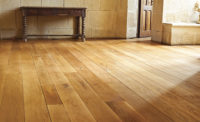Soy-Based Wood Stain Takes Environmental Approach to Preserve Wood and Concrete

Many coating agents simply glaze the top layer of wood and wear away over a brief period of time. According to NCC President Tom Rauls, "AgriStain penetrates the growth cells of the wood, which adds two important features: preservation and colorization. Penetration into soft woods has been observed in multiple growth rings."
"Once the growth ring is saturated with the soy-based solvent, it continues to spread throughout the wood, regardless of the season," says Rauls. "The soybean base in AgriStain aids in actually tricking the wood into believing that summer never ends, which, in effect, causes the continual spreading and sealing of the stain in the product year-round."
Rauls notes that the final result is "a wood product that displays a reduction in splintering, contains a softer texture, expands the life of the wood, shows signs of resistance to mildew and a reduction in discoloration."
Test sites in four areas of the country were started last year. Decks in Florida, Georgia, Michigan and Arizona were each stained and treated with AgriStain to see how the product withstands different weather conditions. While these tests are still being carried out, no technical information is being released. Results are expected to be available for public release within the next six months. So far preliminary results are favorable.
"The decks have held the stain amazingly well," said Rauls. "We check in on the test sites every few months and most look like they were just stained. There is very little discoloration or fading."
In addition to wood staining, AgriStain also effectively stains concrete and cement siding. "AgriStain takes the same approach in staining brick walls, cement buildings and concrete floors as it does with wood," says Rauls. "It's fairly common that painted fiber cement hides the wood pattern; however, when penetrated with AgriStain, fiber cement structures exhibit the look of real wood."
AgriStain can be used to create designs on concrete floors, revitalize brick buildings, colorize concrete landscapes and pool ornaments as well as artistically stain porous stone. It is easily applicable with conventional methods such as paint rollers, brushes, pump sprayers and airless spray or HVLP spray guns.

According to New Century Coatings, AgriStain goes beyond what conventional coating agents do for wood products. Besides being odorless and nonflammable, biodegradable, containing no irritants and providing easy cleanup, AgriStain contains low VOCs, making it user friendly during application and providing a safe working environment.
For more information on AgriStain, contact New Century Coatings at 602/625.8925 or e-mail ncc@cox.net.
To learn more about soy-based products, visit the United Soybean Board at www.unitedsoybean.org/newuses.
Looking for a reprint of this article?
From high-res PDFs to custom plaques, order your copy today!






